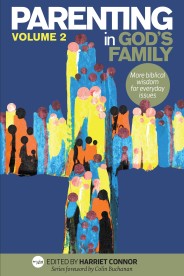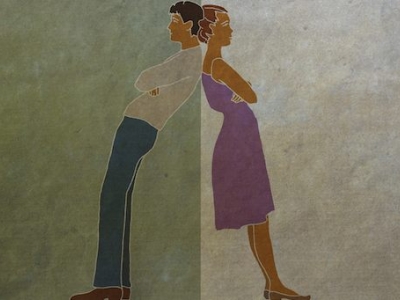
The controversy jar
How one family practises the dying art of robust discussion.
'As iron sharpens iron,
so one person sharpens another.' (Proverbs 27:17)
As a mother of many children and as an observer of society, it seems to me that we are losing the skill of discussing different points of view. It is bigger than losing the skill to agree to disagree, although that is part of it. I regularly hear and experience discussions in which participants will dance around a topic—seeking common ground by avoiding anything that could be disagreeable.
I’ve always loved the lines near the end of To Kill a Mockingbird, in which Scout stands on Boo Radley’s porch and finally understands her father’s previous insight about walking in someone else’s shoes, seeing things from their perspective. I wonder if this is part of the skill that I worry is being lost. And I don’t think that means you have to agree with people, it just means that for starters, you listen. You listen to them in order to see how they came to their conclusions. I am concerned that the art of robust discussion is being lost—discussion where we don’t all agree on a given topic, but we can affirm that we still care more for the relationship than we do about agreeing with each other. These discussions can only happen in relationships where we confront our differences rather than politely avoid discussing them.
Another observation I have made makes me quite sad. Parents have become busier and busier with work commitments as they seek to provide and care for their families, and some topics which should be raised and discussed or taught at home are being missed. An example of this is the topic of abortion; another example is euthanasia. Many of my peers are shocked to find that their Christian teenage children think abortion is always a good thing. Yet when they think back, they realise that they never chatted with their children about it. It’s really easy to assume that our children agree with us about some topics, without realising we’ve never actually discussed them.
As I made these observations, I wondered what topics my own family had avoided or neglected to discuss. And as I listened to my children, I wondered if they had learnt the skill of respectful disagreeing discussion. Had my children learnt what ‘iron sharpening iron’ might look like? And so my husband and I bought a cheap glass jar, ripped up strips of paper, and made ‘the controversy jar’, in which anyone in the family could write down a controversial statement and place it inside. And every so often, after dinner, we take the jar, and pull out a few statements, and practise discussing, listening, disagreeing, thinking. This process has been fascinating and incredibly helpful.
It has taken a lot of self-discipline for our family. It turns out when there are seven of us, all with surprisingly strong opinions, we have had to learn simple skills like giving everyone an opportunity to speak uninterrupted. This is not as easy as one might think! The ability to show restraint and not interrupt is really difficult. We have also had to learn to stay on topic and not deviate. I was surprised how often we do not agree with each other. This has been very helpful because we are all learning that we can disagree on a topic, but still love each other. We can also learn from each other—even as parents. It has been humbling for me to have my initial opinion changed by insight from my children.
As a parent it has also taught me what is close to my children’s hearts. Each piece of paper they put in the jar reflects what they are thinking about. And hearing them discuss is teaching me what observations and experiences they have in the world. I learn how they phrase things, what interactions and information they’ve been taught that informs their opinions. It gives everyone, from oldest to youngest, the opportunity to speak, to think, to listen, to formulate and articulate opinions.
We also have many light-hearted topics in the jar, and this has been great for practising the skill we’re all trying to improve. An example of this would be: ‘The music of the Lord of the Rings movies is better than the music of the Star Wars movies’. We had strong opinions all round, but this was one we could laugh about afterwards, because it really is a matter of preference. The skill of discussing helps sharpen our ability to see whether conclusions are based on mere preferences or not. The ability to differentiate between preferences and truths is so important.
We have come a long way in discussions by using the controversy jar. And we still have a lot to learn. There have been occasions when the discussion has ended in tears for some. Yet I think all of my family enjoy our after-dinner controversy jar nights. And I hope the skills we are trying to sharpen will benefit us all long term, because I think we are trying to put James’ words into practice when he says:
My dear brothers and sisters, take note of this: Everyone should be quick to listen, slow to speak and slow to become angry, because human anger does not produce the righteousness that God desires. (James 1:19–20)
---
Ruth Barry was raised in a loving Christian home and has always known Jesus as her King. She’s married to Andrew, senior pastor of Menai Anglican Church, and they have six children: five living with them and one now safe in the arms of Jesus. Ruth is a contributor to the forthcoming book, Parenting in God’s Family Volume 2: More Biblical Wisdom for Everyday Issues.

Coming soon: Parenting in God's Family Volume 2:
More Biblical Wisdom for Everyday Issues.

A Sneaking Suspicion
John Dickson's engaging evangelistic book for young people discusses things that matter—things like life, death, relationships, sex, suffering, meaning and God—things that are important but which we don't often talk about.
For more articles from Growing Faith, subscribe to our monthly e-newsletter.
To hear about the latest books and resources from Youthworks Media, subscribe here.








